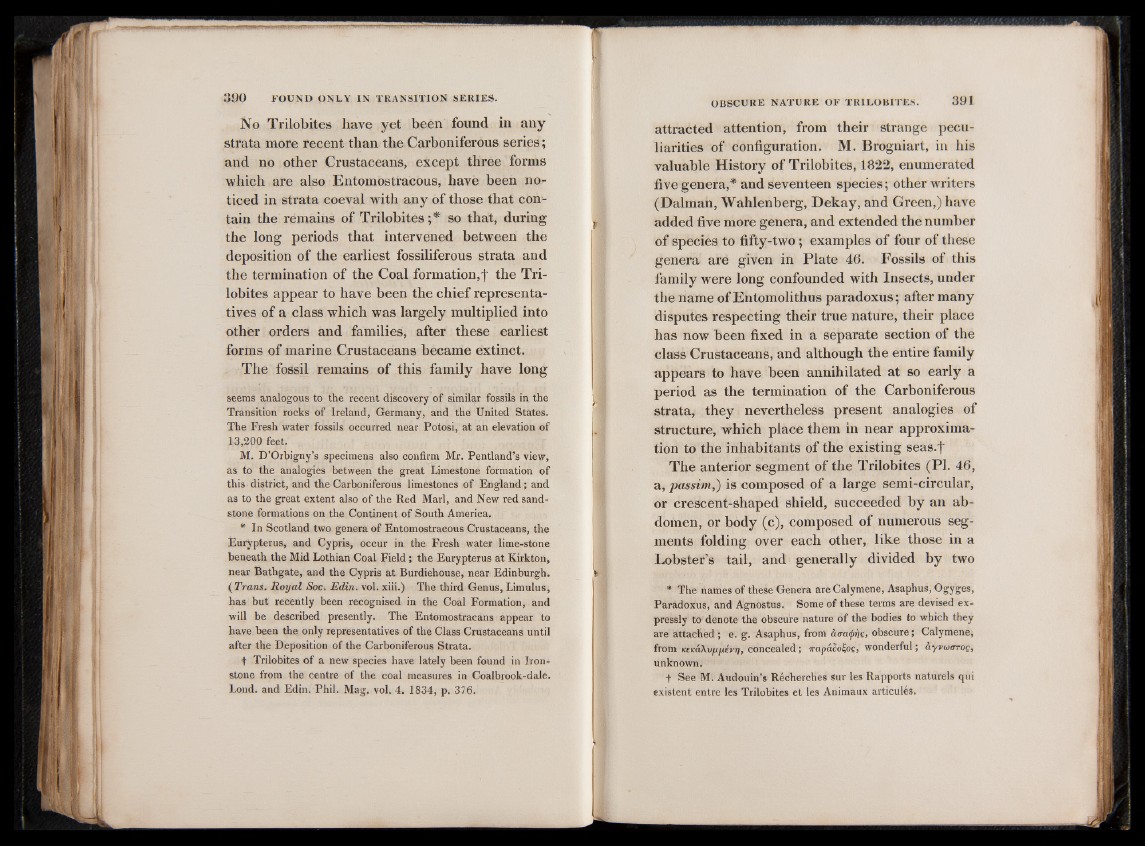
No Trilobites have yet been found in any
strata more recent than the Carboniferous series;
and no other Crustaceans, except three forms
which are also Entomostracous, havé been noticed
in strata coeval with any of those that contain
the remains of Trilobites;* so that, during
the long periods that intervened between the
deposition of the earliest fossiliferous strata and
the termination of the Coal formation,f the Trilobites
appear to have been the chief representatives
of a class which was largely multiplied into
other orders and families, after these earliest
forms of marine Crustaceans became extinct.
The fossil remains of this family have long
seems analogous to the recent discovery of similar fossils in the
Transition rocks of Ireland, Germany, and the United States.
The Fresh water fossils occurred near Potosi, at an elevation of
13,200 feet.
M. D ’Orbigny’s specimens also confirm Mr. Pentland’s view,
as to the analogies between the great Limestone formation of
this district, and the Carboniferous limestones of England; and
as to the great extent also of the Red Marl, and New red sandstone
formations on the Continent of South America.
* In Scotland two genera of Entomostracous Crustaceans, the
Eurypterus, and Cypris, occur in the Fresh water lime-stone
beneath the Mid Lothian Coal Field; the Eurypterus at Kirkton,
near Bathgate, and the Cypris at Burdiehouse, near Edinburgh.
(Trans. Royal Soc. Edin. vol. xiii.) The third Genus, Limulus,
has but recently been recognised in the Coal Formation, and
will be described presently. The Entomostracans appear to
have been the only representatives of the Class Crustaceans until
after the Deposition of the Carboniferous Strata.
•f Trilobites o f a new species have lately been found in Ironstone
from the centre of the coal measures in Coalbrook-dale.
Lond. and Edin. Phil. Mag. vol. 4. 1834, p. 376.
attracted attention, from their strange peculiarities
of configuration. M. Brogniart, in his
valuable History of Trilobites, 1822, enumerated
five genera,* and seventeen species; other writers
(Dalman, Wahlenberg, Dekay, and Green,) have
added five more genera, and extended the number
of species to fifty-two; examples of four of these
genera are given in Plate 46. Fossils of this
family were long confounded with Insects, under
the name ofEntomolithus paradoxus; after many
disputes respecting their true nature, their place
has now been fixed in a separate section of the
class Crustaceans, and although the entire family
appears to have been annihilated at so early a
period as the termination of the Carboniferous
strata, they nevertheless present analogies of
structure, which place them in near approximation
to the inhabitants of the existing seas.f
The anterior segment of the Trilobites (PI. 46,
a, passim,) is composed of a large semi-circular,
or crescent-shaped shield, succeeded by an abdomen,
or body (c), composed of numerous segments
folding over each other, like those in a
Lobster’s tail, and generally divided by two
* The names of these Genera areCalymene, Asaphus, Ogyges,
Paradoxus, and Agnostus. Some of these terms are devised expressly
to denote the obscure nature of the bodies to which they
are attached; e. g. Asaphus, from ittrafijc, obscure; Calymene,
from KEKakvyyivri, concealed; irapaoo^oc, wonderful; ayvwtrrot,
unknown.
f See M. Audouin’s Recherches Sur les Rapports naturels qui
existent entre les Trilobites et les Animaux articules.